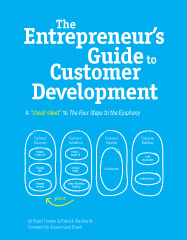Editor’s note: This is a cross post from Flow Ventures written by Raymond Luk (LinkedIn, @rayluk). Follow him on Twitter @rayluk. This post was originally published in January 12, 2012 on Flow Ventures.

![]() Some rights reserved by Maximus_W
Some rights reserved by Maximus_W
I was having coffee with a founder the other day and we started talking about his hiring plans. Since he’s a non-technical founder (which Ben Yoskovitz claims is a dead-end to begin with) he had several top coders in mind, all of whom were earning big bucks with larger companies.
“I’m paying them a little bit of money but they’ll join full time once I can raise money,” said the founder. It’s something I hear a lot, especially from non-techie founders.
I went back to review some blog posts on Lean hiring, and I came across Eric’s post “Lean Hiring Tips” and Mark MacLeod’s “Fat Hiring for Lean Startups“. Both are worth your time. But I think they’re also written for startups that are already up and running and need to expand. I’m interested in very early stage hiring, e.g. when you’re one person looking for a co-founder or you’re two people looking for your core team.
Companies always take on the characteristics of their founders and in the rush to scale, I find many startups don’t stop to consider how they’re establishing the DNA of their company. The first few hires are the most important ones you’ll make.
- Hire for an experimental mindset – Look for people who enjoy encountering problems, designing ways to solve them, and finding proof of success or failure. Skill at building, whether it’s software or a marketing plan or a sales funnel, is irrelevant at this point. You need people who will volunteer to scrap their plans, not fight you when you want to change course.
How? Join a hackathon, Lean Machine or just create your own (laptop + Starbucks = hackathon). Give your (potential) team a crazy challenge and see who exhibits the right behaviours.
- Hire generalists – A lot of people will disagree with this advice. If you can find the best Python developer in the country go for it. But only if she’s also willing to cold call customers, crank out some Web site copy and help you whiteboard the business model. Your #1 focus is to find a business model that works. The latent technical talent on your bench won’t help you unless you graduate from this first phase
How? Again, hackathons are great practical tests. No matter what their skillset, look for passion about your business model and solving customer problems.
- Prioritize UX over development – This is easier said than done since there’s a shortage of UX talent. But it’s better to have a kick-ass UX person and a mediocre developer than the other way around. UX will help you find your business model and most (good) UX people already have an experimental mindset and generalist attitude
How? Actively seek out UX people, not just developers. You may need to work at a distance if you can’t find local talent. Consider working with less experienced people if they can prove themselves through testing.
- Get skin in the game – Leaving a six figure job to join your startup for a paycut is not skin in the game, or not enough in my books. Hire those people later when you’ve found your business model, have money in the bank, and need to scale. Skin in the game means working full time, just like you are. It means putting their reputation on the line, raising Ramen funding from friends/family/spouses and saying “I’m going to see this through until we fail.”
How? Stop feeling like you’re a poor startup that can’t afford to pay top salaries. Those aren’t the droids you’re looking for. Think of finding your co-founders like raising your first round. You need to get them excited to invest in your business.
I know this advice seems to apply better to “Web” startups than general technology startups, which is a common criticism of Lean startups in general. But I think it applies more broadly. If you hire for the right attitude, you not only solve the critical product-market fit problem, but you set the DNA of your business right from the start. I guess I haven’t seen too many examples of startups failing because they lacked a specific technical skill. They probably think they failed because of it though.
In the end, I guess “hiring” is the wrong word to begin with. You’re looking for people to co-found a business with you. You aren’t buying their skills, you’re asking them to invest in helping you shape the course of your business from the very beginning. Maybe not all of them (including yourself) will be able to scale up with the business. That’s a problem for another day.
Editor’s note: This is a cross post from Flow Ventures written by Raymond Luk (LinkedIn, @rayluk). Follow him on Twitter @rayluk. This post was originally published in January 12, 2012 on Flow Ventures.


